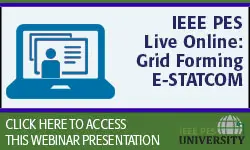Studies for Planning HVDC
Malsha Annakkage, Sahar Azad, Mike Barnes, Jef Beerten, Girish Behal, Hakan Ergun, Ani Gole, Oriol Gorris Bellmunt, Kyeon Hur, Lee Jaegul, Zhang Jinhua, Ghuan Kim, Stefanie Kuenzel, Abhay Kumar, Anne-Katrin Marten, Ke Meng, Chong Ng, Vajira S. Pathirana, Robin Preece, Udeesha Samarasekera, Jiyoung Song, Tuan Trinh, Dirk Van Hertem, Dirk Westermann, Willie Wong
-
Members: FreePES
IEEE Members: $45.00
Non-members: $70.00Pages/Slides: 102
Technical Report
25 Feb 2021
This IEEE Technical Report entitled “Studies for Planning HVDC” prepared by the Transmission & Distribution Committee, HVDC & FACTS Subcommittee, Working Group 15.05.18 gives an overview of general steps/studies which are necessary during an HVDC project. They are structured in
- "Transmission Expansion Plan" which scopes future changes or expansions of the existing power system in a time range of around 4 to 40 years from now. To do so, different scenarios are evaluated considering factors such as economic growth and varying shares of generation technology. The results are new transmission projects to increase or maintain transmission capacity and reliability in a power system.
- “Feasibility Studies” estimate, at an early project state, the impact of a new HVDC connection to the existing AC system. Therefore, feasibility studies are divided in two parts. The first one defines AC and preliminary DC parameters, routes and technology (e.g. LCC or VSC). With this as an input, the second part performs studies which look at interactions with the existing AC power system, such as torsional interaction and short circuit capability.
- “Specification Studies” have the scope to define a tender document including a technical specification. The studies consist of a technical and non-technical part of which this document only describe the technical specifications. Furthermore, some of the topics are an update/more detailed version of its precursor in the feasibility studies section. In this case the focus is on additional information rather than describing the whole process again. The technical specification studies can roughly be divided in two parts. A simulation part where simulations are performed to identify required behavior and a formal requirement part, where a general behavior is described in existing and public documents.
- “Tender Phase” is based on specifications and defines the general performance of the HVDC connection and its price. Therefore, system engineering defines the main circuit parameter, AC system integration & interaction, losses, external insulation & air clearance and low frequency characteristic. Afterwards, converter station design defines the electrical interference, electromagnetic fields audible noise and civil engineering. All results of this phase are not final and have the intention to give a good representation of the performance and costs of the project. In this document only the parts of system engineering are further described.
- “Project Execution” provides more detailed versions of tendering phase studies. Therefore, the main circuit parameters are determined, and low frequency characteristic, external insulation & air clearance and losses are extended.
In this report not all possible options which are in use around the world are discussed and the descriptions should be seen more as an example. Due to the complexity and amount of studies, not detailed descriptions are given, but rather an introduction with references to more detailed study descriptions.
- "Transmission Expansion Plan" which scopes future changes or expansions of the existing power system in a time range of around 4 to 40 years from now. To do so, different scenarios are evaluated considering factors such as economic growth and varying shares of generation technology. The results are new transmission projects to increase or maintain transmission capacity and reliability in a power system.
- “Feasibility Studies” estimate, at an early project state, the impact of a new HVDC connection to the existing AC system. Therefore, feasibility studies are divided in two parts. The first one defines AC and preliminary DC parameters, routes and technology (e.g. LCC or VSC). With this as an input, the second part performs studies which look at interactions with the existing AC power system, such as torsional interaction and short circuit capability.
- “Specification Studies” have the scope to define a tender document including a technical specification. The studies consist of a technical and non-technical part of which this document only describe the technical specifications. Furthermore, some of the topics are an update/more detailed version of its precursor in the feasibility studies section. In this case the focus is on additional information rather than describing the whole process again. The technical specification studies can roughly be divided in two parts. A simulation part where simulations are performed to identify required behavior and a formal requirement part, where a general behavior is described in existing and public documents.
- “Tender Phase” is based on specifications and defines the general performance of the HVDC connection and its price. Therefore, system engineering defines the main circuit parameter, AC system integration & interaction, losses, external insulation & air clearance and low frequency characteristic. Afterwards, converter station design defines the electrical interference, electromagnetic fields audible noise and civil engineering. All results of this phase are not final and have the intention to give a good representation of the performance and costs of the project. In this document only the parts of system engineering are further described.
- “Project Execution” provides more detailed versions of tendering phase studies. Therefore, the main circuit parameters are determined, and low frequency characteristic, external insulation & air clearance and losses are extended.
In this report not all possible options which are in use around the world are discussed and the descriptions should be seen more as an example. Due to the complexity and amount of studies, not detailed descriptions are given, but rather an introduction with references to more detailed study descriptions.
Chairs:
Chairs: Teeuwsen, Simon and Renner, Robert H.
Primary Committee:
Transmission & Distribution Committee (T&D)
Sponsor Committees:
HVDC & FACTS Subcommittee, Working Group 15.05.18 Studies for Planning of HVDC


